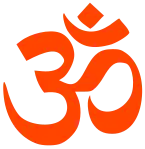Savarna (gotra)
Savarna (Sanskrit: सावर्ण, IAST: sāvarṇa) or Savarni/Shavarna is a Brahmin gotra[1] that comprises Kanyakubja Brahmins who are the descendants of sage Savarna Muni.[2][3] The origins of Savarna gotra can be traced back to the origins of Kanyakubja Brahmins in Kannauj, Uttar Pradesh.[4]
| Part of a series on |
| Hinduism |
|---|
 |
|
History & beliefs
Savarna Brahmins are believed to be the descendants of sage Savarna Muni (or Savarni Muni), belonging to the family of Bhrigu.[5] Several ancient Indian literary works and inscriptions suggest that Savarna Brahmins have five Pravaras - Aurva, Chyavana, Bhargava, Jamadagnya and Apnavana.[6]
Savarna Brahmins have historically been the followers of Samaveda, with Gandharva Veda being their preferred Upa Veda (sub-Veda).[7]
According to the kulapanjikas, the genealogical chronicles of some Bengali Brahmin communities, Savarna gotra Brahmins were one of the five Brahmin gotras (along with Shandilya, Bharadwaj, Kashyap and Vatsya) that immigrated from Uttar Pradesh and Bihar to Bengal in the 11th century.[8] This branch of Bengali Savarna Brahmins is known as Kulin Brahmins, who are further classified in two sections based on their geographic characteristics - Rarhi Brahmins and Varendra Brahmins.[9]
Present
Today, Brahmins of Savarna gotra can be found across India and Nepal. However, their surnames vary from region to region.[10]
Savarna Brahmins in Western, Central and Northern India usually carry 'Trivedi (Tiwari or Tripathi)', 'Dwivedi (Mishra or Dubey)', Pandey or Upadhyay as their surnames while the ones in West Bengal and Orrisa would put Ganguly or Gangopadhyay.
Notable People
- Sourav Ganguly, Former Indian cricket captain and current BCCI President
- Manoj Tiwari, Indian politician, currently actor serving as the Member of Parliament from North East Delhi
- Kedar Nath Upadhyay, Chief Justice of Nepal at Supreme Court
- Kisari Mohan Ganguli, Indian translator (Mahabharata into English)
- Narayan Gangopadhyay (1918–1970), Bengali writer
- Chandra Shekhar Azad (born Chandrashekhar Tiwari), Indian independence activist
See also
References
- Tagore, Sourindra Mohun (1884). The Caste System of the Hindus. Catholic orphan Press, Oxford University. p. 16.
- "Vedamal". Raja Ravi Sekhar. Retrieved 6 December 2019.
- Bhattacharya, Tanmoy. "Traditional genealogy of bengali brahmins: gaGgopAdhyAYa and other families of sAvarNa gotra". Tripod. Retrieved 6 December 2019.
- Williams, Raymond Brady (4 January 2011). An introduction to Swaminarayan Hinduism. Cambridge University Press. p. 13. ISBN 052165422X. Retrieved 6 December 2019.
- Brough, John (2013). The Early Brahmanical System of Gotra and Pravara: A Translation of the Gotra-Pravara-Manjari of Purusottama-Pandita. Cambridge University Press. p. 82. ISBN 1107623987. Retrieved 6 December 2019.
- Sharma, R.K. (1965). A STUDY OF THE GOTRAS AND PRAVARAS IN THE KALACHURI INSCRIPTIONS. Indian History Congress. pp. 92–98.
- Crooke, William (1999). The Tribes and Castes of the North-Western Provinces and Oudh. Asian Educational Services. p. 146. ISBN 8120612108. Retrieved 6 December 2019.
- Bhattacharya, Amit. "Indian roots and shoots: Five Brahmins and a migration myth". The Times of India. The Times of India. Retrieved 6 December 2019.
- "Kulin Brahmins". Rediff.com. Rediff.com. Retrieved 6 December 2019.
- Witzel, M. (1989). "Swati Datta (nee Sen Gupta), Migrant Br ! hma " as in Northern India. Their Settlement and General Impact c. A.D. 475-1030". XV. Cite journal requires
|journal=(help)